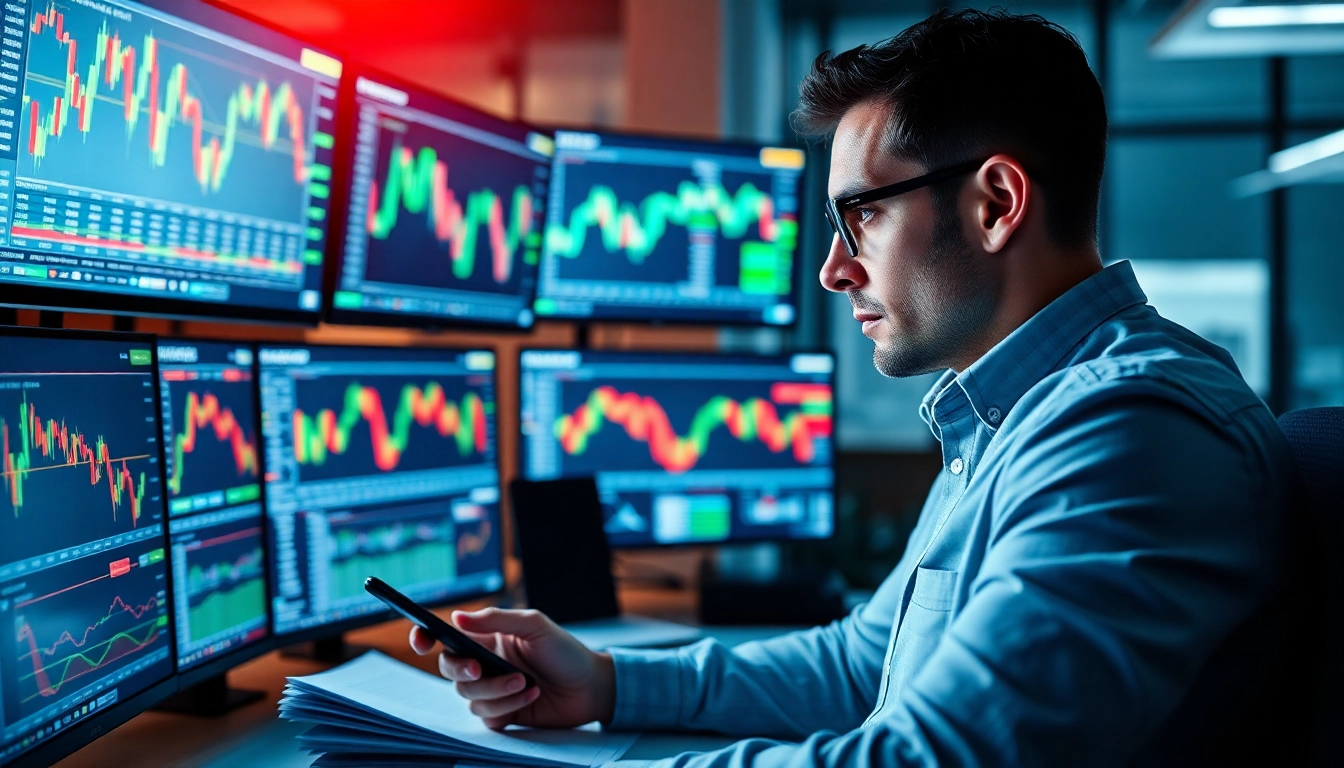Understanding Forex Trading Basics
What is Forex Trading?
Forex trading, short for foreign exchange trading, refers to the act of buying and selling currencies in a global decentralized marketplace. This market is vast, operating 24 hours a day, five days a week, and has become increasingly popular among traders due to its high liquidity and potential for profitability. The key concept behind forex trading is to exchange one currency for another, betting on whether the value of one will rise or fall relative to another. For instance, if a trader believes that the Euro will strengthen against the US Dollar, they will buy Euros and sell Dollars simultaneously.
This dynamic marketplace, known as the foreign exchange market, is considered the largest financial market in the world, where currencies worth trillions of dollars are traded daily. To gain a more thorough understanding of this market, traders often rely on various strategies, analytical methods, and risk management techniques. Engaging in forex trading can be both exciting and risky, particularly for beginners who might not fully grasp the intricacies involved.
The History of Forex Trading
The origins of forex trading trace back to ancient civilizations when merchants exchanged different currencies. However, the modern form of forex trading began after the establishment of the Bretton Woods system in the mid-20th century. This system was an agreement among major world economies to fix their currencies’ values against the US Dollar, creating a peg system.
In 1971, the world saw the collapse of the Bretton Woods System, leading to the adoption of a floating exchange rate system where currency values are determined by supply and demand. This paradigm shift resulted in the establishment of forex trading as we know it today, with technological advancements facilitating online trading. The globalization of financial markets and advancements in telecommunications allowed individual traders to enter this previously institution-dominated realm.
Key Terms Every Trader Should Know
Understanding key terminology is essential for anyone looking to enter the forex market. Here are some fundamental terms:
- Currency Pair: A quotation of two different currencies, with one being the base currency and the other the quote currency.
- Pips: The smallest price move that a given exchange rate can make based on market convention.
- Leverage: The use of borrowed funds to increase the potential return on investment. In forex, it allows traders to control larger positions with a smaller amount of capital.
- Spread: The difference between the bid price and the asking price of a currency pair.
- Lot: A standardized unit of measure for trading. Forex trades are made in lots, typically known as standard lots, mini lots, and micro lots.
- Margin: The collateral that a trader must deposit to open a position, usually expressed as a percentage of the total trade value.
How to Get Started in Forex Trading
Selecting a Forex Trading Platform
Choosing the right trading platform is crucial as it will serve as your gateway to the forex market. A good forex trading platform should be user-friendly, offer a variety of currencies, include advanced analytical tools, and have a secure environment for transactions. Popular platforms like MetaTrader 4 (MT4) and MetaTrader 5 (MT5) offer customizable interfaces, advanced charting options, and automated trading capabilities.
When selecting a platform, consider factors such as the quality of customer support, reputation, the availability of demo accounts, and the transaction costs associated with trading. Additionally, ensure that the platform you choose is regulated by a recognized authority, which provides an added layer of security for your investments.
Creating a Trading Account
After selecting a trading platform, the next step is to create a forex trading account. This process typically involves choosing between a demo account and a live trading account. A demo account allows new traders to practice without risking real money, providing a risk-free environment to develop their trading skills and strategies.
To set up a live account, traders need to fill out necessary forms, provide identification, and deposit an initial amount of capital. It’s essential to understand the different types of accounts offered by brokers, such as standard accounts, micro accounts, and managed accounts. Each type comes with different spreads, leverage options, and commission structures, impacting your overall trading strategy and risk management.
Forex Trading Strategies for Beginners
Developing a sound trading strategy is key to achieving success in the forex market. Beginners often face the challenge of finding a strategy that aligns with their risk appetite and trading style. Here are several strategies worth exploring:
- Day Trading: Involves executing trades and closing them on the same day. This strategy requires real-time analysis and quick decision-making.
- Swing Trading: This method includes holding positions for several days or weeks to capitalize on expected market moves. It’s suitable for those who cannot spend the entire day monitoring the markets.
- Scalping: A highly rapid trading approach where traders take advantage of small price movements, holding positions for a matter of seconds or minutes.
- Position Trading: A long-term strategy where traders hold positions for months or even years, relying on fundamental analysis and longer-term market trends.
Regardless of the strategy chosen, continuous learning and adaptation are essential, as forex markets are influenced by countless factors, including economic indicators, geopolitical events, and market sentiment.
Advanced Forex Trading Techniques
Leveraging Technical Analysis
Technical analysis involves studying price movements and historical data to forecast future price actions. This approach uses various tools and indicators, such as moving averages, relative strength index (RSI), and Fibonacci retracement levels, to identify patterns and possible entry and exit points.
Many traders rely on charts to visualize market movements and to spot trends, reversals, or continuation patterns. Understanding chart patterns, such as head and shoulders or double tops/bottoms, can provide valuable insights. Moreover, utilizing moving averages allows traders to smooth out fluctuations in prices, thus identifying a more accurate trend direction.
Understanding Economic Indicators
Economic indicators are statistics or data reports that reflect a country’s economic performance and influence currency values. Key indicators include:
- Gross Domestic Product (GDP): A measure of a country’s overall economic output and health.
- Employment Data: Employment rates and job creation numbers provide insights into economic strength.
- Inflation Rates: Rising inflation can affect interest rates and, thus, currency value.
- Central Bank Policies: Interest rate changes and monetary policy announcements can significantly impact currency exchange rates.
Traders who can interpret economic data accurately can make informed decisions on currency pairs and enhance their trading strategies.
Implementing Risk Management Strategies
Effective risk management is crucial in forex trading to protect your capital and minimize losses. Traders should employ techniques such as:
- Setting Stop-Loss Orders: Automatically closes a position at a predetermined price to limit potential losses and protect your trading account.
- Diversification: Spreading investments across multiple currency pairs can reduce the impact of adverse price movements.
- Position Sizing: Determining the amount of capital to risk on each trade to avoid overexposure to any single market movement.
Understanding the ratio of potential reward to risk is essential for making sound trading decisions and achieving long-term success.
Tools and Resources for Forex Trading
Top Forex Trading Tools for Professionals
Successful traders leverage a variety of tools and resources to achieve their trading goals. Key tools include:
- Trading Platforms: Platforms like MetaTrader and cTrader offer extensive functionality, including charting, trading signals, and automated trading capabilities.
- News Feeds: Real-time news updates provide critical information that can influence market conditions and sentiment.
- Economic Calendars: These calendars keep track of upcoming economic data releases and events that affect currency pairs.
Essential Forex Trading Apps
In today’s fast-paced trading environment, having access to mobile trading apps is vital. Several applications allow traders to stay connected to the markets and manage their accounts remotely. Popular apps include:
- MetaTrader 4 Mobile: Lets forex traders trade on the go while accessing real-time quotes and advanced trading features.
- TradingView: Offers extensive charting capabilities and social networking features for traders to share ideas and strategies.
- Thinkorswim: A powerful platform known for its research tools and intuitive mobile interface.
Where to Find Forex Trading Communities
Engaging with fellow traders can offer invaluable insights and support. Numerous online communities and forums exist where traders can share experiences, trade ideas, and seek advice. Some popular platforms include:
- Forex Factory: A forum dedicated to forex trading, where traders can discuss strategies, news, and market sentiment.
- BabyPips: An educational website and community that caters to both beginner and experienced traders, covering a wide range of topics.
- Reddit: Subreddits like r/Forex provide a platform for traders to share information, ask questions, and connect with others.
Performance Metrics in Forex Trading
Measuring Trading Success
Performance metrics are essential to evaluate the effectiveness and profitability of your trading strategies. Key metrics include:
- Win Rate: The percentage of profitable trades relative to the total number of trades taken.
- Risk-Reward Ratio: The ratio of potential profit to potential loss in each trade, helping to assess the efficacy of your trading strategy.
- Annualized Return: The return on investment over the year, providing insights into long-term performance.
Analyzing Trade Performance
To continually improve as a trader, it’s crucial to analyze individual trade performance. This involves looking back at your trades to understand what worked, what didn’t, and the psychological factors at play. Keeping a trading journal can be beneficial for maintaining detailed records of your trades, noting down the rationale behind each decision, and tracking performance over time.
Adjusting Strategies Based on Metrics
Once you measure performance metrics, the next step is to adjust your trading strategies accordingly. If your win rate is low, you might need to refine your entry and exit criteria or reconsider your risk management approach. Regularly assessing your performance allows you to identify areas of strength and weakness, fostering a cycle of continuous improvement and successful trading.



